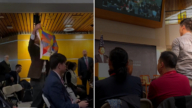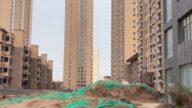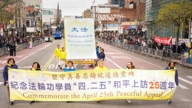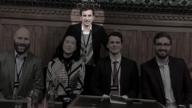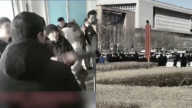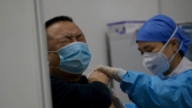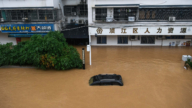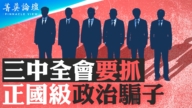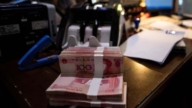【新唐人2011年8月6日訊】中國社會科學院8月3號發佈的《中國城市發展報告》表示,中國城市貧困人口達到5千萬人,呈現不斷上升的趨勢。而海內外專家指出,5千萬城市貧困人口被嚴重低估。經濟學家謝國忠表示,中國當前的體制只能讓少數人受益,是赤裸裸的劫窮濟富。
社科院的這份報告以城市貧困人口比例在7.5%到8.7%之間保守估算,得出中國城市貧困人口約有5千萬人,年均收入7500元到8500元人民幣,月均收入只有6、7百元。當中有一半的人沒有受到政府的最低生活保障照顧。
住房與城鄉建設部政策研究中心主任陳淮等專家認為,5千萬隻是第六次人口普查數據6.6億城鎮人口的近8%,中國城市中只有7-8%的人是貧困人口,這個估計恐怕過低。
這份報告顯示,西部和中部的貧困人口都大約在1700萬人左右,東北地區有845萬人,最富裕的東部地區也有756萬人貧困。
報告指出,中國城市貧困人口從1990年代後就呈現不斷上升的趨勢,原因是物價不斷上漲、社會保障措施不力、房價頻頻攀升、就業形勢嚴峻、貧富差距不斷擴大。
這份報告的作者之一、北京城市學院講師蔣貴鳳表示,中國城市貧困主要是從國有企業改革、產業結構調整、一些資源性城市逐漸枯竭,造成大量失業人口開始的。
去年9月在第65屆聯合國大會上,溫家寶發表講話承認,中國有1.5億人口生活在聯合國設定的貧困線之下。而海內外專家指出,溫家寶的這個數字也估計過低。
財經評論家草庵居士:「聯合國規定每天收入在1.25美元以下的人屬於甚麼人呢?是赤貧的人口;一天收入2美元以下的是貧困人口。如果說我們提高到1.25美元這個標準線是多少?2億5千萬人是赤貧的;如果達到2美元收入的時候是多少?全中國有9億人口是屬於聯合國規定的貧困人口。」
商務部長陳德銘承認,中國貧困人口在世界上排名第二。在今年兩會期間,全國政協委員瀋雯在一份提案中指出,目前中國的貧困線1196元是政府2009年制定的,太低的貧困線讓過億居民人為的「被脫貧」。
《中國城市發展報告》副主編宋迎昌列舉了城市貧困問題的具體表現,包括:農民工工資較低、房價上漲過快、交通擁堵、看病上學難等等。
一些專家認為,城市貧困惡化現象將加劇社會衝突,陷入惡性循環。宋迎昌表示,現時多個社會問題,源於政策脫離民生需要,社會過份以經濟為核心發展,長此以往,經濟和社會都不能持續發展。
前中國經濟體改所綜合研究室主任程曉農:「真正的問題是所謂的收入分配兩極分化和社會貧困化,或者相對貧困化。空談改善收入分配,而不改善經濟結構,那是不可能實現的。」
經濟學家謝國忠7月28號指出,北京政府一直都試圖無視潛在問題,通過濫發貨幣、大肆增加政府財政支出來推進經濟發展。中國目前的增長模式,只能讓很少一部分掌管國有資產、控制公共財政支出的人受益。
他表示,而在過去幾年內,持續上升的房價和通脹,儲蓄貶值,把更多的人拋棄在後面。比如說,一年期存款利率應該儘快調高到6%。讓利率保持這麼低的水平,就是赤裸裸地搶劫窮人,養肥富人。
《炎黃春秋》雜誌副社長、原新華社高級記者楊繼繩:「市場經濟以後,行政權力沒有得到改革,還是政經不分,很多經濟活動需要官員審批,誰能夠接近審批權力的人,誰就可以得到很多財富,所以,權力進入市場。」
《中國當代社會階層分析》一書作者楊繼繩指出,所謂的「中國模式」,就是這種權力市場經濟模式,它的必然結果是社會不公正,貧富兩極分化,腐敗叢生,民怨沸騰,會產生仇官仇富的社會心理。不搞政治體制改革,中國社會的高壓鍋最終會爆炸,既得利益階層也會完蛋。
新唐人記者李元翰、肖顏綜合報導。
Urban Poverty Underestimated
On August 3, Chinese Academy of Social Sciences (CASS)
released the China Urban Development Report,
indicating that China’s poor urban population
is 50 million, and is still increasing.
Domestic and overseas experts point out that the
“50 million" mark has been seriously underestimated.
Economist Xie Guozhong said China’s current system
can only benefit a few. It is plain robbing of the poor.
An Chinese Academy of Social Sciences report estimated that
with a conservative ratio of urban poor to entire population
being 7.5-8.7%,
Poor urban people in China are about 50 million.
Their annual income is RMB 7,500 to 8,500 (US$1,250).
Half of them have not received
the government’s minimum living allowance.
Expert and Director, Chen Huai
from the department of Housing and Urban Construction,
said 50 million is just about 8% of the 660 million
urban population. The estimation may be too low.
The report shows that poor people in the Western
and Central regions of the country are about 17 million each.
There are about 8.45 million poor in the Northeastern region.
The richest Eastern region has 7.56 million people in poverty.
The report points out that China’s poor urban people
have been increasing in number since the 1990s.
Reasons include inflation, weak social security measures,
rising housing prices, increasing unemployment,
and the growing wealth gap between the rich and the poor.
One of the authors of the report, Jiang Guifeng,
a lecturer at Beijing City University,
said China’s urban poverty started mainly from state-owned
enterprise reform, industrial structure adjustment,
and the gradual depletion of some resources in the cities,
causing heavy unemployment.
In September 2010, in the 65th UN General Assembly,
Chinese Premier Wen Jiabao recognized during his speech,
that China has 150 million people
living under the poverty line as set by the UN.
Domestic and overseas experts pointed out
that Wen’s estimate was too low.
Caoan Jushi (a financial analyst) told Radio Sound of Hope,
“United Nations defined people with a daily income of
less than $1.25 as extremely poor; less than $2 a day as poor.
If we use $1.25 as a base line,
then 250 million people are in extreme poverty.
With $2 as the standard daily income,
900 million people are poor in China."
Minister of Commerce, Chen Deming, acknowledged
that China’s poor people ranked second in the world.
During 2011』s Two Communist Party meetings,
Shen Wen, member of the Chinese People’s Political
Consultative Conference (CPPCC), said in a proposal that
the current poverty line is RMB 1196, set in 2009.
A low poverty line puts millions “out of poverty."
China Urban Development Report deputy editor,
Song Yingchang, gave examples of of urban poverty,
including lower wages of migrant workers,
soaring housing prices, traffic congestion,
and lack of access to medical care and education.
Some experts believe that urban poverty will exacerbate
social conflicts, creating a vicious cycle.
Song says that the current social issues came from policies
not focusing on people』s living, but on economic development.
In the long run, the economy and the society cannot
be prioritized simultaneously.
Cheng Xiaonong (former Director of Integrated Research
Office of Economy Reform Institute) told Radio Free Asia,
“The real problem is the so-called polarization
of income distribution and social impoverishment,
or relative impoverishment. Improving income distribution
will be impossible if the economic structure is not improved."
Economist Xie said on July 28, that the Beijing government
has been trying to ignore the potential problems,
improving economy by printing cash
and increasing government expenditure.
China’s current growth model can only benefit a few
who are in charge of state assets and public expenditures.
Xie thinks that over the past few years, devaluation of savings
and rising prices and inflation pushed more people backward.
For example, the current one-year deposit rate
should be raised to 6% soon.
Allowing interest rates to keep at such a low level
is blatantly robbing the poor and enriching the wealthy.
Yang Jisheng (Vice President of Chronicles of History,
former senior reporter of Xinhua News) told RFI:
“In a market economy, the executive power is not reformed,
but it still mixes political and economic powers.
Many economic activities require officials』 approval.
Those close to authorities can obtain more fortune.
So the political power entered the market."
“Contemporary Analysis of China』s Social Class" author,
Yang pointed out that the so-called 『Chinese model』
is the political power market economy model,
which will inevitably result in a social injustice,
polarization between rich and poor, rampant corruption,
public complaints, and hatred toward the rich.
Without a political reform, China’s social pressure-cooker
will explode, destroying those with vested interests.
NTD reporters Li Yuanhan and Xiao Yan.


